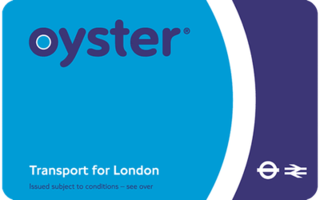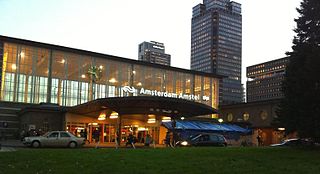
Nederlandse Spoorwegen is the principal passenger railway operator in the Netherlands. It is a Dutch state-owned company founded in 1938. The Dutch rail network is the busiest in the European Union, and the third busiest in the world after Switzerland and Japan.

There are currently 401 railway stations in the Netherlands including four which are used only during special events and one which serves the National Railway Museum only. NS Stations is the body which manages and owns all railway stations in the Netherlands.

GVB is the municipal public transport operator for Amsterdam, the capital of the Netherlands, operating metro, tram, bus and ferry services in the metropolitan area of Amsterdam.

The Oyster card is a payment method for public transport in London, England, United Kingdom. A standard Oyster card is a blue credit-card-sized stored-value contactless smart card. It is promoted by Transport for London (TfL) and can be used on as part of London's integrated transport network on travel modes including London Buses, London Underground, the Docklands Light Railway (DLR), London Overground, Tramlink, some river boat services, and most National Rail services within the London fare zones. Since its introduction in June 2003, more than 86 million cards have been used.

MIFARE is a series of integrated circuit (IC) chips used in contactless smart cards and proximity cards.
The London Underground and Docklands Light Railway (DLR) metro systems of London, England uses a mix of paper and electronic smart-card ticketing.

Amsterdam Centraal station is the largest railway station in Amsterdam, North Holland, the Netherlands. A major international railway hub, it is used by 192,000 passengers a day, making it the second busiest railway station in the country after Utrecht Centraal and the most visited Rijksmonument of the Netherlands.

Rotterdamse Elektrische Tram is the main public transport operator in Rotterdam, Netherlands. It started in 1905 when they took over the city tram lines from RTM. It currently operates 64 bus lines, 11 tram lines and five metro/light rail lines in Rotterdam and the surrounding municipalities.

Rejsekort is an electronic ticket system for public transport in Denmark. The system is a collaborative work between DSB, HUR, Ørestadsselskabet, and various regional bus companies, and work on it started on August 18, 2003. In June 2005, Thales Group and Accenture were chosen as suppliers.

The Breeze Card is an American stored value smart card that passengers use as part of an automated fare collection system which the Metropolitan Atlanta Rapid Transit Authority (MARTA) introduced to the general public in early October 2006. The card automatically debits the cost of the passenger’s ride when placed on or near the Breeze Target at the fare gate. Transit riders are able to add value or time-based passes to the card at Breeze Vending Machines (BVM) located at all MARTA stations. The major phases of MARTA's Breeze transformation took place before July 1, 2007 when customers were still able to purchase TransCards from ridestores or their employers. They were also able to obtain paper transfers from bus drivers to access the train. As of July 1, 2007 the TransCard and the paper transfers were discontinued and patrons now use a Breeze Card or ticket to access the system, and all transfers are loaded on the card. Breeze Vending Machines (BVM) distribute regional transit provider passes The Breeze Card employs passive RFID technology currently in use in many transit systems around the world.

The national tariff system is a ticketing and zoning scheme for local public transport in the Netherlands. It was designed as a nationwide scheme but is being phased out and replaced by the OV-chipkaart. With the abolition of the strippenkaart on 3 November 2011, only the sterabonnement remains organized under the national tariff system. The system does not apply to Dutch Railways (NS), which have their own pricing regime; however, there are limited sections of railway on which the system is valid.

Rail transport in the Netherlands uses a dense railway network which connects nearly all major towns and cities. There are as many train stations as there are municipalities in the Netherlands. The network totals 3,223 route km (2,003 mi) on 6,830 kilometres (4,240 mi) of track; a line may run both ways, or two lines may run on major routes. Three-quarters of the lines have been electrified.

A transit pass or travel card, often referred to as a bus pass or train pass etc., is a ticket that allows a passenger of the service to take either a certain number of pre-purchased trips or unlimited trips within a fixed period of time.
The go card is an electronic smartcard ticketing system developed by Cubic Corporation, which is currently used on the Translink public transport network in South East Queensland, Australia. To use the go card, users hold the card less than 10 cm away from the reader to "touch on" before starting a journey, and must do the same to "touch off" the service at the end of the journey. The cost of each journey is deducted from the go card balance.

Amsterdam Amstel is a railway station in Amsterdam, Netherlands. The station opened in 1939. It is located to the southeast of Amsterdam Centraal in the borough of Amsterdam-Oost, near the Amstel river. Amsterdam Amstel is used daily by 50,000 train and metro passengers. Rail services at the station are provided by NS, the principal railway operator in the Netherlands. Metro, tram and city bus services are provided by municipal operator GVB. Regional buses are operated by Transdev and Keolis.

Nijmegen railway station is the main railway station of Nijmegen in Gelderland, Netherlands. It was opened on 9 August 1865 and is located on the Tilburg–Nijmegen railway, Nijmegen–Venlo railway and the Arnhem–Nijmegen railway. It was extensively rebuilt after the war since the original station was severely damaged by a US bombing raid in February 1944 and during Operation Market Garden in September 1944. Until 1991 there was a line into Germany from here to Kleve.
Integrated ticketing allows a person to make a journey that involves transfers within or between different transport modes with a single ticket that is valid for the complete journey, modes being buses, trains, subways, ferries, etc. The purpose of integrated ticketing is to encourage people to use public transport by simplifying switching between transport modes and by increasing the efficiency of the services.
The main public transport in the Netherlands for longer distances is by train. Long-distance buses are limited to a few missing railway connections. Regional and local public transport is by bus and in some cities by metro and tram. There are also ferries.

The TFI Leap Card is a contactless smart card for automated fare collection overseen by Transport for Ireland (TFI). It was introduced in the Greater Dublin area in 2011 for Luas, DART, Iarnród Éireann and Dublin Bus, but acceptance has significantly expanded, and it is now accepted in cities nationwide and on some longer distance commuter routes. Initially, Leap Cards offered only a pre-paid electronic wallet system for single-trip fares; since May 2014, it has also been possible to load it with weekly, monthly and annual subscriptions. In September 2017, there were over 2.5 million Leap Card users according to the National Transport Authority. The Leap Card is the result of many years' work by the Railway Procurement Agency and the National Transport Authority as part of the rollout of an integrated ticketing scheme for public transport in Dublin city. Fares are generally discounted compared to cash prices, and integrated ticketing is offered in the Dublin area via a flat fare system across all modes of transport. The minimum top-up for the card is currently €5, and it can be topped up via iPhone/Android App, at LUAS or DART ticketing machines, and in convenience stores offering Payzone services.
MOBIB, also written as MoBIB, is a contactless smart card used as an integrated ticketing system for 'travel products' of most public transport in the Belgium. First introduced by Brussels' MIVB in 2008, it has since has expanded to include the public transport operators NMBS, De Lijn, and TEC. Each operator issues a MOBIB card with a unique design, but it can be used with all four operators. Transport tickets are usually specific to each operator, though some subscriptions, such as 'Brupass' and 'Brupass XL', are valid across multiple operators.






















